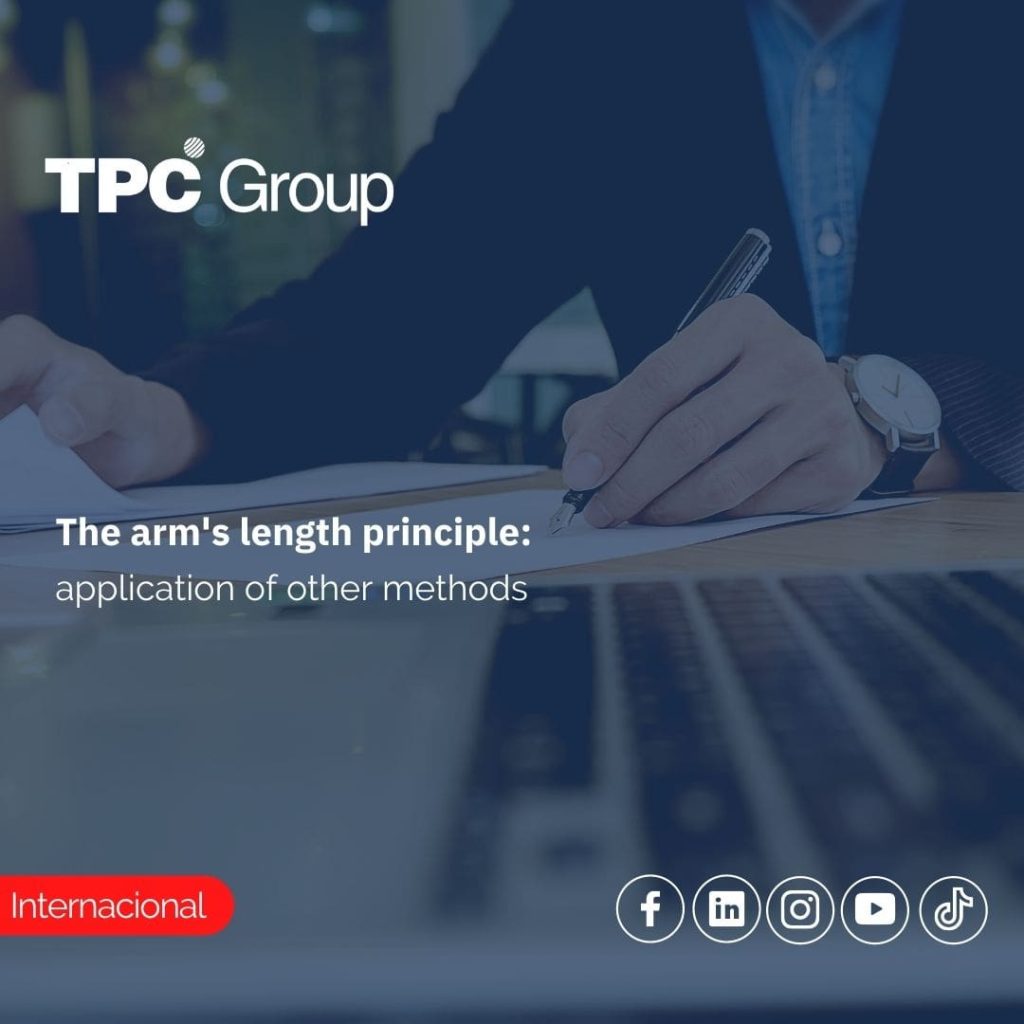OECD member countries recognize the arm’s length principle as the most efficient and effective method for the proper assessment of transfer prices in transactions between associated enterprises. This assurance is granted thanks to the accurate approach in which the method analyzes the operation of the transfer of goods (Tangible and Intangible) within a global market.
It is important to note that it is not always easy to apply the arm’s length method in reality. However, in most cases, it is the only means that can provide appropriate levels of estimates and percentages for the payment and collection of taxes that satisfy both the multinational groups and their members, as well as the different tax administrations.
1. Separation of the arm’s length principle
In previous lines, we have explained the importance of the application of the arm’s length method and its effectiveness at the moment of offering results, according to the expectations of the administered (Multinationals and their partners) and their respective auditing entities. (Tax auditing agencies of each country).
The reason why the aforementioned principle is applied in a standardized manner is because of the lack of solidity of other methods for the tax laws of each country, exposing the international consensus and increasing the likelihood that the States of each country refuse to standardize their legislation and thus create situations of double taxation.
The harmony that has been generated at present, under the use of this tax scheme, between the tax administrations and the multinational business community generates a great added value to the method since it lays the foundations for eventual global uniform taxation.
Following the above, it is important to point out that, although it is the most effective method, and currently the only one of real application, there are other methods, which some experts consider may be sufficient to be considered to supplement the arm’s length principle. The most relevant alternative method among those who oppose full competition is the “Global Apportionment of the Form.” However, as we will see below, the method application in question is not acceptable in theory, implementation or practice.
2. Global Form Apportionment
The alternative method called “Global Apportionment of Form” is presented as an additional alternative to determine the number of benefits received by the different corporate groups in their jurisdictions. By its very nature, the application of the method in question has only been carried out in local tax jurisdictions but has been attempted on a global basis. As defined in the guidelines;
“Global apportionment of the form allocates the global profits of a multinational group on a consolidated basis among associated enterprises in different jurisdictions based on a predetermined and mechanistic formula. There would be three essential components to applying global apportionment of the form: determining the unit to be taxed, i.e., which of the subsidiaries and branches of a multinational group should comprise the global taxable entity; determining precisely the global profits; establishing the formula to be used for the allocation of the unit’s global profits. The formula will most likely be based on some combination of costs, assets, payroll, and sales.” (OECD;2022)3
It is important to note that the “Global Apportionment of Form” must be differentiated from the method called “Transactional Earnings.” The “Global” method uses a formula that is already predetermined for all taxpayers and serves the function of guiding them to the appropriate allocation of profits, while the “Profits” methods compare in each particular case, the income generated between one or more members of a multinational group with that generated between independent companies within comparable circumstances.
Also, the global method should not be confused with the application of a specific tax formulation for a taxpayer. This is because there are multiple scenarios in which the different tax administrations can agree with their respective multinational taxpayers on formulas that apply to their operations after having performed a specific analysis of the circumstances and facts of that particular corporate group.
3. Comparison with the arm’s length principle
Thus, according to the aforementioned theory, it is necessary to compare the differences between the two methods and find out the reason to apply the arm’s length principle under the OECD guidelines.
According to the advocates of the Global method, it serves to analyze the economic reality of corporate groups. Under their scheme, multinational groups should be considered a corporate grouping that reflects the realities of the operations carried out among its members. For these individuals, the separate accounting method is inappropriate for integrated groups because it is difficult to determine the contribution made by each of the associated companies to the overall profit of the multinational group.
In addition to the above argument, it is also argued that the Global Form Apportionment method reduces compliance costs for taxpayers because, in principle, only one specific group of accountants would be required to prepare the tax documents for the local jurisdiction of the group.
Despite the above, OECD member countries do not accept the Global method as a realistic alternative to the arm’s length method because the Global Apportionment of Form makes it difficult for the legal systems in each jurisdiction to ensure an audit that prevents double taxation and rather ensures uniform taxation for the economic group.
The complication lies in the fact that, for the Global method, it is necessary to define a general formula applicable to all. However, as we have seen in the course of this analysis, in many cases, it is necessary to carry out a particular examination of the situations and facts that influence a transaction between the group to give a result that meets the expectations of both taxpayers, and the tax administration.
As discussed in the OECD Guide: “[…] For example, to avoid double taxation there would need to be a common agreement to adopt the approach in the first instance, followed by agreement on the measurement of the overall tax base of a multinational group, on the use of a common accounting system, on the factors to be used to apportion the tax base between different jurisdictions (including non-member countries), the form to measure, and weigh those factors. Reaching such an agreement would be time-consuming and extremely difficult. It is far from clear that jurisdictions would be willing to accept a universal formula.”4 (OECD; 2022)
Following the above, it can be stated that, even if some jurisdictions are willing to accept the Global Form Apportionment method, it would still not be feasible, since each jurisdiction will seek in some way or another to include factors or elements to the formula that predominate or that benefit in some way their jurisdictions.
Under such a scheme, each Government (Tax Administration) would have strong incentives to propose formulas that maximize the collection revenues of each of its jurisdictions. With this paradigm, another problem is tax avoidance since different elements of the formula may be susceptible to manipulation and include or disregard unnecessary or necessary financial transactions depending on each particular case.
4. Additional problems with the Global method
Due to the characteristics of the Global method, we can affirm that its implementation would represent a major problem at a political and administrative level. Due to the nature of multinational companies, to achieve the tax utopia proposed by the global method, it would be necessary for all the jurisdictions in which the company has operations to reach a point of equilibrium concerning their tax policies, which is practically impossible scenario.
The consequence of a lack of consensus would mean the imposition of a double burden to be met by multinational companies since they would be obliged to adapt to the legislation of each country in which they operate.
In addition to the problem of double taxation, another dilemma that arises is the arbitrariness that can be taken into account when defining the predetermined formulas, which may not take into consideration the real market conditions, the unique circumstances faced by each company, and the allocation of resources issued by the management bodies thus resulting in an allocation of income that does not take into consideration many specific and relevant facts that are part of the transaction.
In other words, the subjectivity of the method can result in a formula based on a combination of cost, assets, payroll, and sales, which implicitly imputes a fixed rate of profit per monetary unit (as is the case of the dollar, euro, yen, etc.) of each component for each member of the group and in each tax jurisdiction, regardless of the differences in functions, assets, risks, and efficiencies that exist between the members of the MNE group. Because of these characteristics, the “alternative” approach could potentially allocate profits to an entity that would incur losses if it were a stand-alone company.
Another issue that arises from the Global Apportionment Form is dealing with exchange rate fluctuation. Although it is true that this variable also affects the arm’s length principle, the impact generated on the results is not the same. Under that figure, the arm’s length principle is better equipped to deal with the economic consequences of exchange rate movements because it requires analysis of the specific facts and circumstances of the taxpayer.
In contrast, if the formula is cost-based, the result of the application of the global apportionment form would vary based on the strength of each currency vis-à-vis a jurisdiction with more favorable currency conditions. Therefore, under global form apportionment, exchange rate movement could mean increased profits for the associated company operating with the stronger currency, while in the long run, a strengthening currency makes exports less competitive and leads to downward pressure on profits.
5. Information impossible to collect
In the third section of this report, we mentioned the proponents of the Global method and how according to their position, there is a positive factor to the Global method of Form Apportionment, and it is the decrease in associated costs. However, this is a fallacy as the costs of compiling the information can increase exponentially because they will vary based on the currency and tax accounting rules of each particular jurisdiction.
Therefore, the documentation and compliance requirements for a global apportionment application would generally be more onerous than under the separate entity approach of the arm’s length principle. The costs of a global apportionment of the form would be further magnified if not all jurisdictions can agree on the components of the formula or how the components are measured.
In addition, problems would also arise in determining the sales of each member and, in turn, in valuing the assets they hold. Furthermore, these difficulties can be compounded by different tax jurisdictions, accounting standards, and multiple currencies. Therefore, accounting standards across all jurisdictions would have to conform to such information to arrive at a meaningful measure of profit for the entire multinational group.
Clearly, of course, these difficulties also exist under the arm’s length principle. However, for this method, significant progress has been made concerning applicable solutions, whereas no solution has been proposed to date that effectively implements the global apportionment of the form.
6. Effects of the application of the Global Apportionment of the form
If, after all the above considerations, it is still sought to apply the Global Apportionment of the form, this would have a negative effect because it taxes the corporate groups on a consolidated basis, and therefore it abandons the approach of analyzing it individually. Consequently, this method cannot recognize important geographic differences, individual company efficiencies, and other specific factors affecting the group companies or its members.
Due to the lack of the above capabilities, the application of the global method would raise questions regarding the appropriateness of imposing withholding taxes on cross-border customers concerning payments between group members, which would imply the rejection of a number of the rules incorporated in the bilateral tax treaties.
The only way to avoid the issues raised, the Global Apportionment form must include all members of the multinational group and must maintain uniformity in the calculation of the transactions of all members of the group. This implies a great disadvantage for the group since it will have to comply with all the rules set forth by each tax administration.
In any case, the multinational group will be obliged to keep an accounting of corporations that are not members of the MNE group for apportionment of the form for tax purposes but are still associated companies of one or more members of the MNE group. Many local business and accounting operations would continue to require the use of arm’s length pricing (e.g., customs rules) so that regardless of tax provisions, a taxpayer would have to record each transaction at arm’s length prices.
7. Conclusions
In summary, OECD member countries will continue to apply only the arm’s length principle due to the effectiveness and efficiency that the method has demonstrated over the years. With this, the uniformity of the arm’s length principle is materialized, and the rejection of the “alternative” method called “Global Apportionment of the Form” is exposed.
Jose Fernando Sobrevilla Rivera




